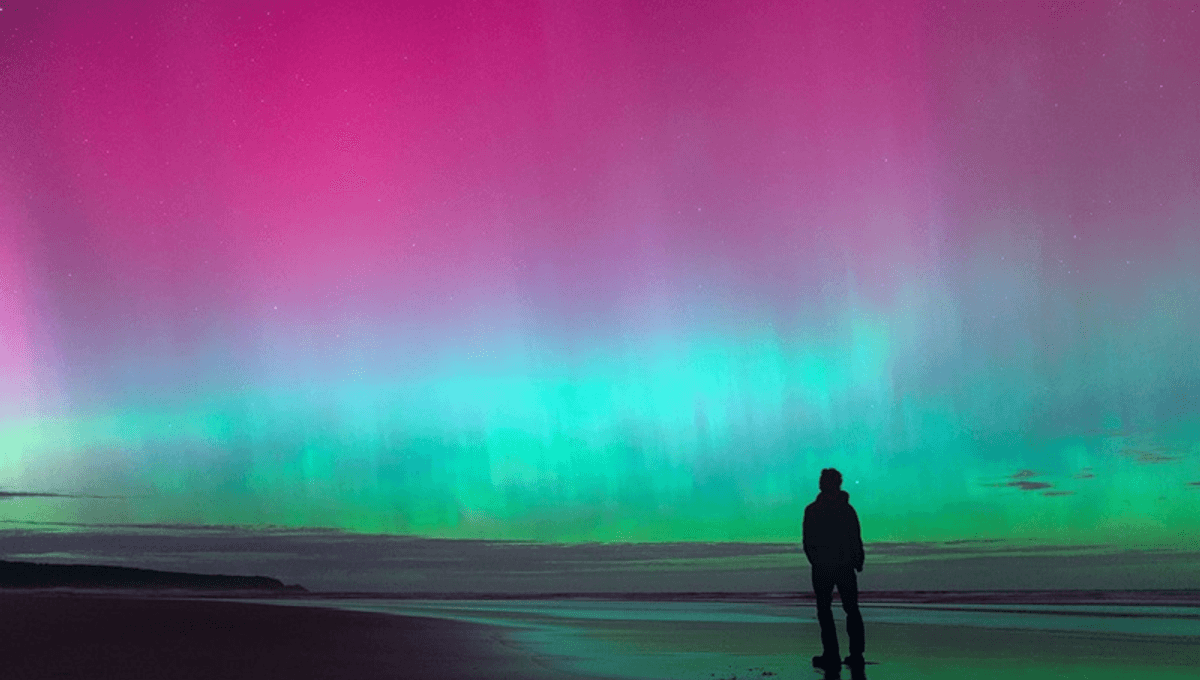
This weekend was a treat for lovers of the night sky all the way to mid-latitudes. The intense solar activity of the past week culminated in an extreme auroral event seen even to latitudes where you usually do not see such night sky spectacle. Social media was wonderfully inundated with pictures – probably helped by it being the weekend – and we saw many people wonder what was happening and how common this event was.
The NOAA Space Weather Prediction Center reported that the planet experienced an extreme geomagnetic storm (G5 category), the strongest event since Halloween 2003. Back then, the event was intense enough to cause generator faults in Sweden and South Africa. On average, there are four of these events per every solar cycle.
A solar cycle lasts 11 years. The activity of the Sun goes through a peak known as the maximum and a trough called the minimum. We are approaching the maximum of Cycle 25 (or we are at it). The maximum is always seen after the event. If you are quick at math, you might have noticed that 2003 was more than 11 years ago – but Solar Cycle 24 was quite unusual and not particularly strong, so it did not cause G5 or G4 storms, even though 100 G4 storms are expected each cycle.
As solar activity perks up, the Sun becomes marked by sunspot regions that are slightly cooler than the surrounding area. They possess incredibly strong magnetic fields, and it’s the behavior of these magnetic fields that causes the major events in space weather. The auroral activity of the weekend comes from a sunspot called AR3664, which is 16 times as wide as Earth.
“Magnetic field lines have a special fundamental property – they typically cannot cross each other. This means that as they get twisted and tangled they store energy like a wound up spring. When a so-called ‘magnetic reconnection’ occurs, these fields relax rapidly, which can release explosive energy out into space.” Dr John Morgan, Space Weather Scientist, said in a statement.
Sunspots’ magnetic release can cause solar flares – flashes of light so intense that, as they reach Earth eight minutes later, they ionize atoms in the upper atmosphere, making it puff up. They cause radio blackouts, errors in GPS, and drag on satellites. AR3664 released an X5.8 flare, the second strongest of this cycle so far.
But it’s not just solar flares. There are also coronal mass ejections (CMEs) that make up space weather. These are releases of high-speed plasma from the Sun. Charged particles are currently hitting our planet, but CMEs come in with a lot more energy. These particles are moving at thousands of kilometers per second. Once they get to Earth, they follow the magnetic field lines and slam into the atmosphere around the polar regions.
Well, usually. Places like mainland Australia, Tuscany in Italy, and Southern California are nowhere near the poles, and yet aurora was visible there. Even in places with a lot of light pollution, they were visible. That’s because we had a lot of plasma coming in. Earth was at the right place and the right time for multiple CMEs to hit at once. Three of them merged into a “cannibal CME” because the one released by the Sun last was faster than the other two, gobbling them up.
Some of that plasma got to Earth and slammed into the atmosphere at lower latitudes than usual. So aurorae were visible from a lot of places that usually don’t get them. Another question many people have is: is it going to happen again?
“No-one can know for sure. The events of the last few days certainly seem to be some of the most significant of the smartphone era,” said Morgan. “It’s certainly possible that we’ve just seen the peak of auroral activity for this solar cycle. However, experience tells us that big events can happen even well after the peak of the solar cycle, so for those who missed out, there’s certainly a good chance of comparable events happening over the next few years.”
Let’s hope for more activity as the Sun goes through its maximum.
All “explainer” articles are confirmed by fact checkers to be correct at time of publishing. Text, images, and links may be edited, removed, or added to at a later date to keep information current.
Source Link: Why Were Aurorae Seen So Far Away From The Poles This Weekend?